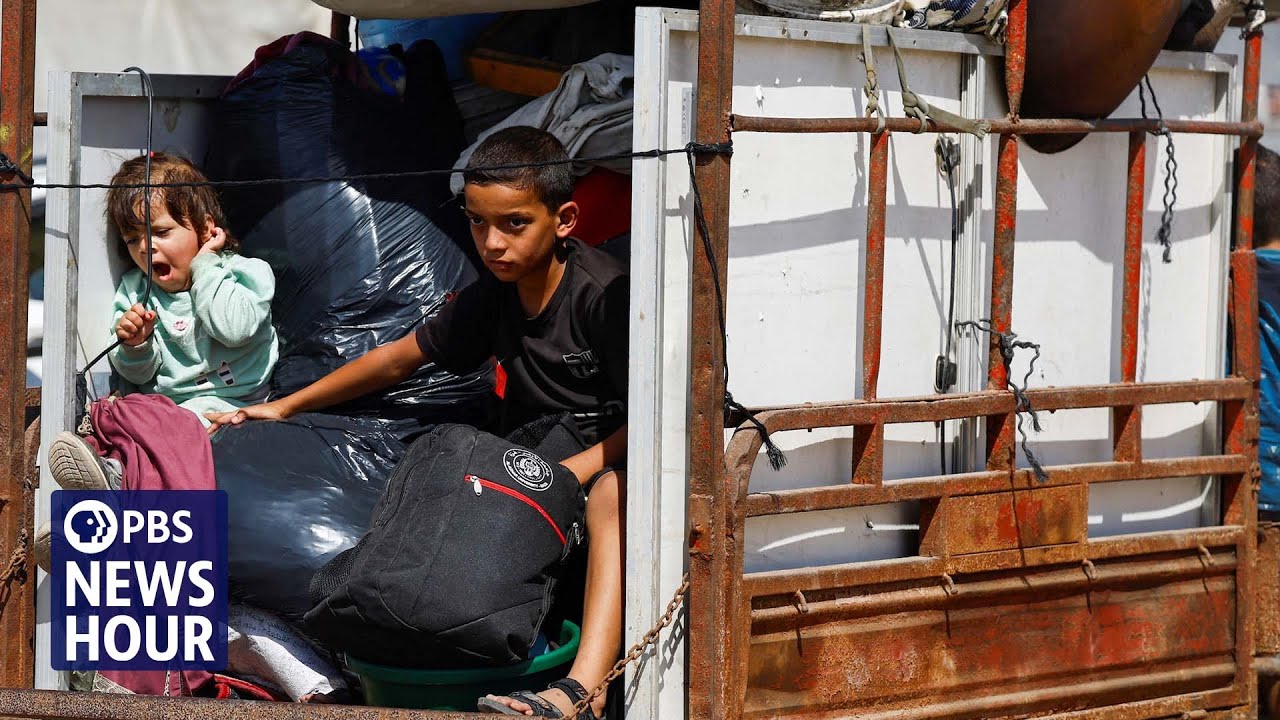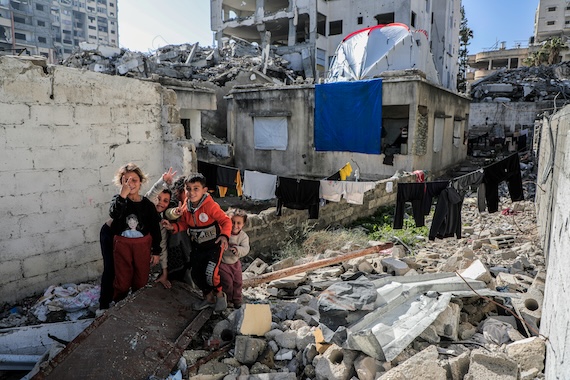Ann Arbor (Informed Comment) – The terms of the Trump ceasefire in Gaza required Israeli authorities to allow 600 trucks of food and medical aid into the Strip daily, in a full court press by the United Nations and NGOs to flood the zone with nutrition after the Israeli blockade provoked famine in parts of Gaza. The Israelis are only allowing 300 trucks a day in. Lorenzo Tondo, William Christouin and Seham Tantesh at The Guardian note that even 600 would not have been enough, but 300 is totally inadequate to the vast needs of half-starving civilians. Half of the people in Gaza are children, many of them emaciated and some of them suffering from severe malnutrition.
At the same time, the World Health Organization is warning of an ongoing and serious outbreak of infectious diseases in Gaza, where Israel destroyed the public health infrastructure with hundreds of attacks on hospitals that it dishonestly accused of being Hamas HQs. The large number of war-wounded are especially vulnerable to these diseases.
WHO reported in early October that of there are 42,000 persons among the 167,376 war-wounded in Gaza with permanent disabilities, with children making up over 10,000 of them.
PBS reports on the tens of thousands of children killed by Israeli troops in Gaza, and the 10,000 permanently disabled:

War leaves Gaza’s children with deep physical wounds and lasting trauma
Here’s a snippet:
- LEILA MOLANA-ALLEN (voice-over):
No sight, no speech, no sound.
Four-year-old Nayel (ph) has had all his senses stolen by an airstrike—and it’s getting worse.
In May, Nayel and his six-year-old brother were playing in the dusty pathways of Gaza’s Nuseirat refugee camp when an Israeli strike hit the tent next to them.
HANI ABU SHALABI, Father of Injured Child (through translator):
They were playing around me when the missiles suddenly hit us and shattered all our dreams and beautiful moments we once had in our life.
LEILA MOLANA-ALLEN (voice-over):
Mohamed was killed instantly. Pieces of shrapnel lodged deep in Nayel’s brain, causing brain damage that has stolen his vision, his hearing, and his speech.
With barely any food or access to clean water—Israel has mostly blocked the delivery of eggs since earlier this spring—he’s suffering from severe malnutrition.
The filthy conditions in the hospital mean he has now caught meningitis too. Unable to chew or move, what food they can get him comes through a feeding tube. His tiny body can’t hold out much longer.
HANI ABU SHALABI (through translator):
Before the war, Nayel was one of the most active children. He loved to play a lot, and we used to go to the beach together. He’s in pain right now—silently in pain—and cries without tears. The doctors here told us they don’t know what to do anymore.
LEILA MOLANA-ALLEN (voice-over):
Nayel’s only chance is to be evacuated from Gaza for specialist treatment. Without it, he will die soon.
He has the travel permit and foreign surgeons desperate to help him. But the Israeli authorities won’t let him cross the border.
One index of how bad the public health situation is can be seen in reports of dozens of cases of Guillain-Barré Syndrome. A deadly auto-immune disease, it strikes people with viral and bacterial infections. The means to treat it were depleted at the few functioning medical centers in Gaza last summer, so victims have just be suffering and dying ever since. Uncontrolled outbreaks of meningitis, diarrhea and respiratory diseases are also being reported by WHO.

Or by check:
Juan Cole
P. O. Box 4218,
Ann Arbor, MI 48104-2548
USA
(Remember, make the checks out to “Juan Cole” or they can’t be cashed)
The Israeli military still occupies 55% of Gaza, so it isn’t much of a ceasefire. The UN Office of the High Commissioner for Human Rights said this week:
- “Israeli forces have redeployed from certain areas while maintaining control of more than 50% of Gaza, including almost all of Rafah and large parts of Khan Younis, Beit Lahiya, Beit Hanoun, as well as parts of Gaza City. Hundreds of thousands of Palestinians are moving back to the areas from which they were displaced, including to areas in close proximity to the remaining Israeli ground forces.
On the morning of 14 October, Israeli military reportedly fired on Palestinians attempting to return to their homes in Ash Shuja’iya, eastern Gaza City, killing three. Later that day, the Israeli military stated its forces shot and killed individuals in northern Gaza who crossed “the withdrawal line” after ignoring Israeli warning.”
The Israeli troops under the increasingly beleaguered international law of war can’t just shoot down civilians for straying over an imaginary line that only the Israelis can see.
Never miss an issue of Informed Comment: Click here to subscribe to our email newsletter! Social media will pretend let you subscribe but then use algorithms to suppress the postings and show you their ads instead. And please, if you see an essay you like, paste it into an email and share with friends.
On Wednesday, the UN Office for the Coordination of Humanitarian Affairs reported that in the first five days of the ceasefire, 390,000 Palestinians hit the road, mainly moving from southern to northern Gaza.
Embed from Getty Images
Crowds and vehicles fill a coastal road as displaced Palestinians travel north in the Gaza Strip on October 11, 2025. Many residents have begun moving back to their neighborhoods following the announcement of a ceasefire between Israel and Hamas. (Photo by Abdelrahman Rashad / Middle East Images via AFP) (Photo by ABDELRAHMAN RASHAD/Middle East Images/AFP via Getty Images)
OCHA quoted the Under-Secretary-General for Humanitarian Affairs and Emergency Relief Coordinator, Tom Fletcher on what needs to be done in Gaza over the next two months to achieve an effective humanitarian response:
*Massive amounts of food aid need to be delivered to the some 2 million people of Gaza.
*Medical care needs to be restored.
*Water networks need to be restored for drinking water and sanitation.
*Shelters need to be set up to help people get through the cold, rainy winter. Over 80% of domiciles are damaged or destroyed and people are sleeping rough or under rickety rubble that could collapse on them.
*Children need to be put back into school after two years of no classes.
*Sustained entry of at least 1.9 million litres of fuel weekly
*Resumption of cooking gas
*Opening of multiple relief corridors supported by functional crossings equipped with additional scanners
*Security guarantees to enable the collection of supplies from crossings
*Restoration of basic infrastructure
*Protection of humanitarian workers
*Rapid and unimpeded passage of aid across Gaza
*Adequate funding
*Facilitation of NGO access, including ensuring that NGOs are not de-registered: The UN cannot operate effectively without its partners.

File Photo of Gaza, Feb 18, 2025, by Mohammed Ibrahim on Unsplash
Moreover, 61 million tons of debris, much of it toxic or riddled with unexploded ordnance, need to be removed. That’s the equivalent of more than 30 million automobiles. That is all the automobiles registered in California, Texas, Ohio and Florida combined.
Even assuming that the Israelis do not fall upon the Palestinian civilians of Gaza again with bombardments and drone strikes, hundreds of thousands of them will likely die of injuries, disease, exposure and other lingering effects of the total war that was waged on them.


 © 2025 All Rights Reserved
© 2025 All Rights Reserved